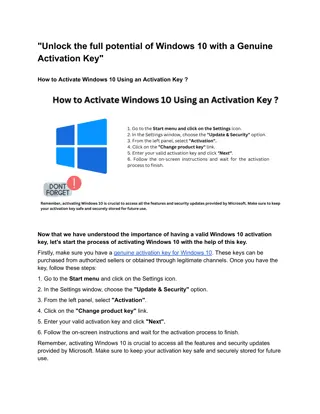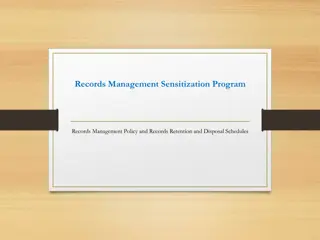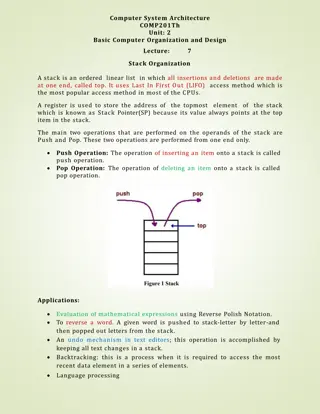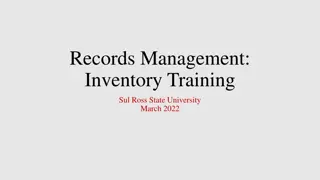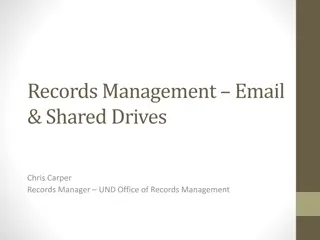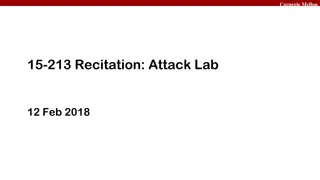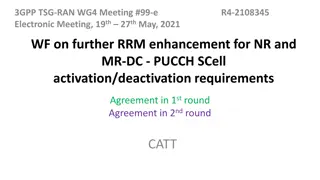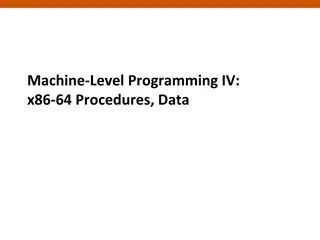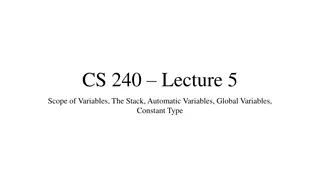Understanding Activation Records and Stack in Assembly Programming
Explore the key concepts of activation records and the stack in assembly programming, including their roles in function calls, memory management, and variable storage. Gain insights into the low-level layout of variables, call conventions in MIPS and x86, and practical examples illustrating stack operations.
Download Presentation

Please find below an Image/Link to download the presentation.
The content on the website is provided AS IS for your information and personal use only. It may not be sold, licensed, or shared on other websites without obtaining consent from the author. Download presentation by click this link. If you encounter any issues during the download, it is possible that the publisher has removed the file from their server.
E N D
Presentation Transcript
CS 0449 Recitation 5 Gordon Lu
Plans for Today Calling Conventions MIPS and x86 correspondences Control Flow, Array-Indexing, etc. Hints on the Traps for the Assembly Lab Buffer Overflow to be reviewed next week Questions on the Queue Lab
WHATS THE STACK? 1) It s an area of memory provided to your program by the OS. When your program starts, it s already there 2) The stack holds information about function calls 3) It s not a strict stack You can read and write any part of it but it grows and shrinks like a stack push and pop describe growth and shrinkage 4) Each program (thread) gets one stack I mean.. cuz one function is running at a time!!
ACTIVATION RECORDS 1) When a function is called, a bunch of data is pushed onto the stack. 2) This is the call s activation record (stack frame) 3) It contains local variables (including arguments) and the return address
AN EXAMPLE ACTIVATION RECORD Stack int main(){ main s caller int help_me, dude; return address help_me dude buf[10] char buf[10]; main s AR return 0; } garbage
THE LOW-LEVEL LAYOUT Each variable (including array variables) gets enough bytes in the AR to hold its value. Where the variable is located is up to the COMPILER!! int x; char arr[3]; short y;
CALL = PUSH, RETURN = POP The stack grows when we call a function, and shrinks when it exits int main(){ void fork(int* ptr){ int x; *ptr = knife(); fork(&x); } return 0; int knife(){ } return 10; }
EXAMPLE The program s AR in main without any other function calls is:
EXAMPLE After fork() is called, the AR becomes:
EXAMPLE After knife() is called within fork(), the AR becomes:
EXAMPLE After knife() is finished returning, the AR becomes:
EXAMPLE After fork() is finished returning, the AR becomes:
RECURSIVE FUNCTIONS Recursive functions work by using the call stack as an implicit stackdata structure.
LIVE EXAMPLE Given the recursive implementation of factorial: int fact(int x){ if(x <= 2){ return x; } else{ return x*fact(x-1); } }
THEY DONT REALLY GO AWAY 1) The stack is used constantly So, it needs to be REALLY FAST 2) So, we implement it as a pointer The stack pointer (sp) 3) Pushing the AR moves the sp down 4) Popping the AR moves the sp up
EXAMPLE Initially, the stack pointer is:
EXAMPLE After pushing onto the call stack, the stack pointer is:
EXAMPLE After popping off the call stack, the stack pointer is:
EXAMPLE The AR s memory is still there, so calling another function is BAD This is where the garbage in uninitialized variables comes from!
x86 Assembly
MIPS vs. x86 MIPS is a RISC ISA: Not many instruction, not human-oriented but easy to build! x86 is a CISC ISA: Lots of instructions, human-oriented but tough to build!
IA-32 vs x86-64 IA-32 is the 32-bit version of x86. Name Meaning Smaller Parts %eax Accumulator %ax, Lower 16 bits of eax, %ah: Upper 8 bits of %ax %al: Lower 8 bits of %ax %ebx Base %bx, Lower 16 bits of ebx, %bh: Upper 8 bits of %bx %bl: Lower 8 bits of %bx %ecx Counter %cx, Lower 16 bits of ecx, %ch: Upper 8 bits of %cx %cl: Lower 8 bits of %cx %edx Data %dx, Lower 16 bits of edx, %dh: Upper 8 bits of %dx %dl: Lower 8 bits of %dx %esi Source Index %si %edi Destination Index %di %esp Stack Pointer %sp %ebp Base Pointer %bp
x86 Registers Name IA-32 Equivalent %rax %eax %rbx %ebx %rcx %ecx %rdx %edx %rsi %esi %rdi %edi $rsp %esp %rbp %ebp %r8 - %r15 %r8d - %r15d
Basic Instruction Types 1) Transferring data between Memory and a Register: (R/I type formats) - Load data from memory into register: %reg = Mem[ lw $t0, arr) - Store register data into memory: Mem[ Mem[addr (arr), $t0) 2) Performing arithmetic operations on a register or memory (R/I type formats) - c = a + b, etc. 3) Control Flow: What instructions come next! (J type formats) - Unconditional jumps - Conditional branches %reg = Mem[addr addr] ] (Analogous to addr] = %reg ] = %reg(Analogous to sw
Basic Operand Types Immediates: Constants - Indicated by $ $ in x86: $560 Register: 16 integer registers, 6 argument registers - % %rsp rsp is special: It s the stack pointer! Memory: Consecutive bytes of memory at a computed address! - (% (%rax rax) ) -> Take data in %rax and get data at that address: *( (rax $560 rax + 0) + 0)
x86 Assembly: Instructions
Moving Data: The mov mov Instruction General Form: mov(_) (_): specializes expected size of operands! Word means 16 bits = 2 bytes in x86 instructions 16 bits = 2 bytes in x86 instructions (equivalent to half-word in MIPS) Examples: Examples: movb b src src, , dest dest movl l src src, , dest dest - Move a single byte byte - - Move 4 byte long movw w src src, , dest dest movq q src src, , dest dest - Move 2-byte word word - Move 8 byte quad mov(_) src src, , dest dest long- -word word quad- -word word
Combinations of Operands with the mov Instruction mov Source Operand Destination Operand Src, Dest C Equivalent Immediate Register movq $0x4, %rax a = 0x4; Immediate Memory movq $-147, (%rax) *ptr = -147 Register Register movq %rax, %rdx dest = source Register Memory movq %rax, (%rdx) *dest_ptr = source Memory Register movq (%rax), %rdx dest = *(ptr_src); The src, dest syntax is known as AT&T syntax This is the opposite format of what MIPS does
Basic Memory Addressing Modes Indirect: Indirect: Mem[Reg[R]] Mem[Reg[R]] The Data in register R R specifies the Memory Address! - Just like Pointer Dereferencing!! - Example: movq movq (%rcx), %rax Displacement: Displacement: Mem[Reg[R] + D] Mem[Reg[R] + D] - Data in register R R specifies the start of some memory region! - Displacement D D specifies offset from that address! - Example: movq movq 8(%rbp), %rdx
Complete Memory Addressing Modes General: General: D(Rb, Ri, S): D(Rb, Ri, S): Mem[Reg[Rb]+ Reg[Ri]*S+D] Mem[Reg[Rb]+ Reg[Ri]*S+D] 1) 1) Rb: Base Register Rb: Base Register (any register) 2) 2) Ri: Index Register Ri: Index Register (any register except % 3) 3) S: Scaling Factor ( S: Scaling Factor (1,2,4,8 (align to type you re working with)) 4) 4) D: Displacement Value D: Displacement Value (aka the immediate Special Cases: Special Cases: Form except %rsp rsp) immediate) Meaning Special Case D(Rb, Ri) Mem[Reg[Rb] + Reg[Ri] + D] (S = 1) (Rb, Ri, S) Mem[Reg[Rb] + Reg[Ri]*S] (D = 0) (Rb, Ri) Mem[Reg[Rb] + Reg[Ri]] (S = 1, D = 0) (, Ri, S) Mem[Reg[Ri] * S] (Rb = 0, D = 0)
Examples What is the C equivalent of the following: -0x4(%rsp, %rbp, 8) *(rsp + (rbp*8) -0x4) (%rdx, %rbx) *(rdx + rbx) 0x8(, %rax, 4) *(rax*4 + 8)
More Address Computation If not specified, the default values are: S = 1, D = 0, Reg[Rb] = 0, Reg[Ri] = 0 Assuming % %rdx rdx = 0xf000, % = 0xf000, %rcx rcx = 0x0100: = 0x0100: S = 1, D = 0, Reg[Rb] = 0, Reg[Ri] = 0 Expression Address Computation Address 0x8(%rdx) Reg[Rb] + D = 0xf000 + 0x8 0xf008 (%rdx, %rcx) 0xf000 + 0x100 0xf100 (%rdx, %rcx, 4) 0xf000 + 0x100*4 0xf400 0x80(,rdx,2) 0xf000*2 + 0x80 0x1e080
Address Computation Instructions leaq leaq src L Load E Effective A Address Q Quad-word - Set destination operand to address denoted by the expression (doesn t go into memory, it just does math!!) Uses: - Computing addressing without memory reference Example: Translation of p = &x[ p = &x[i i]; ]; - Computing arithmetic expressions of the form x + k * y - k = 1, 2, 4, or 8 (offset to get to next multiple of that data type in memory) src, , dest dest x + k * y
x86 Assembly: Conditionals
Condition Codes: Implicit Implicitly set by Arithmetic Operations Example: addq src, dest r = d + s Carry Flag (CF): CF = 1 if Carry Out from MSB (Unsigned Overflow) Zero Flag (ZF): ZF = 1 if r = 0 Sign Flag (SF): SF = 1 if r < 0 (MSB is 1) Overflow Flag (OF): OF = 1 if signed overflow
Condition Codes: Explicit - Compare Explicitly set by the Compare - cmpq cmpq src1, src2 src1, src2 - cmpq cmpq a, b a, b sets flags based on b b a a but does not STORE Compare instruction STORE the result anywhere! Carry Flag (CF): CF = 1 Zero Flag (ZF): ZF = 1 Sign Flag (SF): SF = 1 Overflow Flag (OF): OF = 1 CF = 1 if Carry Out from MSB (Unsigned Overflow ZF = 1 if a == b SF = 1 if (b a) < 0 (MSB is 1) OF = 1 if signed overflow Unsigned Overflow)
Condition Codes: Explicit - Test Explicitly set by the Test - testq testq src2, src1 src2, src1 - testq testq a, b a, b sets flags based on a & b - It s useful to have one of the operands to be a mask Test instruction a & b but does not STORE STORE the result anywhere! mask! Can t have Carry Out or Overflow: CF = 0, OF = 0. Zero Flag (ZF): ZF = 1 ZF = 1 if a & b == 0 Sign Flag (SF): SF = 1 SF = 1 if a & b < 0 (signed)
x86 Assembly: Branching
Using Condition Codes: Jumping j instructions Jumps to a target target address based on condition codes Instruction Meaning jmp target Unconditional jump je target Jump if equal (ZF == 1) jne target Jump if not equal (ZF == 0) js target Jump if negative (SF == 1) jns target Jump if not negative (SF == 0) jg target Jump if greater than (Signed) jge target Jump if greater than or equal (Signed) jl target Jump if less than (Signed) jle target Jump if less than or equal (Signed) ja target Jump if above (Unsigned > ) jb target Jump if below (Unsigned < )
Using Condition Codes: Setting set instructions Sets lower order byte of dst dst to 0 or 1 based on condition codes (7 remaining bytes unchanged) Instruction Meaning sete target Set if equal (ZF == 1) setne target Set if not equal (ZF == 0) sets target Set if negative (SF == 1) setns target Set if not negative (SF == 0) setg target Set if greater than (Signed) setge target Set if greater than or equal (Signed) setl target Set if less than (Signed) setle target Set if less than or equal to (Signed) seta target Set if above (Unsigned > ) setb target Set if below (Unsigned < )
movz_ and movs_ instructions movz_ _ src movs_ _ src 1) Copy from a smaller 2) Source can be memory or register: Destination MUST 3) Fill remaining bits of dest dest with zero movzSD movzSD / / movsSD movsSD: : S: S: Size of Source (b = 1 byte or w = 2) D: Size of Dest (w = 2 bytes, l = 4, q = 8) src, , regDest regDest: Move with zero src, , regDest regDest: Move with sign smaller source to a larger zero extension sign extension larger destination Destination MUST be LARGER zero (movz z) or sign bit sign bit (movs s) LARGER!!
Calling Conventions
Overview Each function call will push an Activation Record stack (This Activation Record will contain all the basic information about the function call (arguments, local variables, return address, other function calls, etc). Returning will pop an Activation Record Activation Record off the call stack. Since the stack is utilized very often throughout a program s duration, we use a stack pointer stack pointer. Push will move the sp sp down, Pop will move the sp Activation Record onto the call sp up
General Idea Every program is almost always 1) A program counter register program counter register (So we can keep track of where we are after a bunch of function calls and branches!) 2) A stack stack to keep track of information across multiple function calls 3) A stack pointer register stack pointer register to push and pop ARs stack! 4) andddd other registers other registers to store local data always going to have: ARs off the call
General Function Calls A function call function call consists of 1) Putting arguments arguments and return address 2) 2) Jumping Jumping to the new function! (jal 3) Setting up the AR AR onto the stack (move the sp return address in the right places!! jal in MIPS MIPS) sp down)
General Function Returns A function return function return consists of 1) Putting the return value return value somewhere ($v0 2) Cleaning up the AR off the stack (move up the sp 3) Jumping back to the return address return address (jr jr ra $v0 in MIPS) sp) ra in MIPS)
MIPS Calling Conventions




